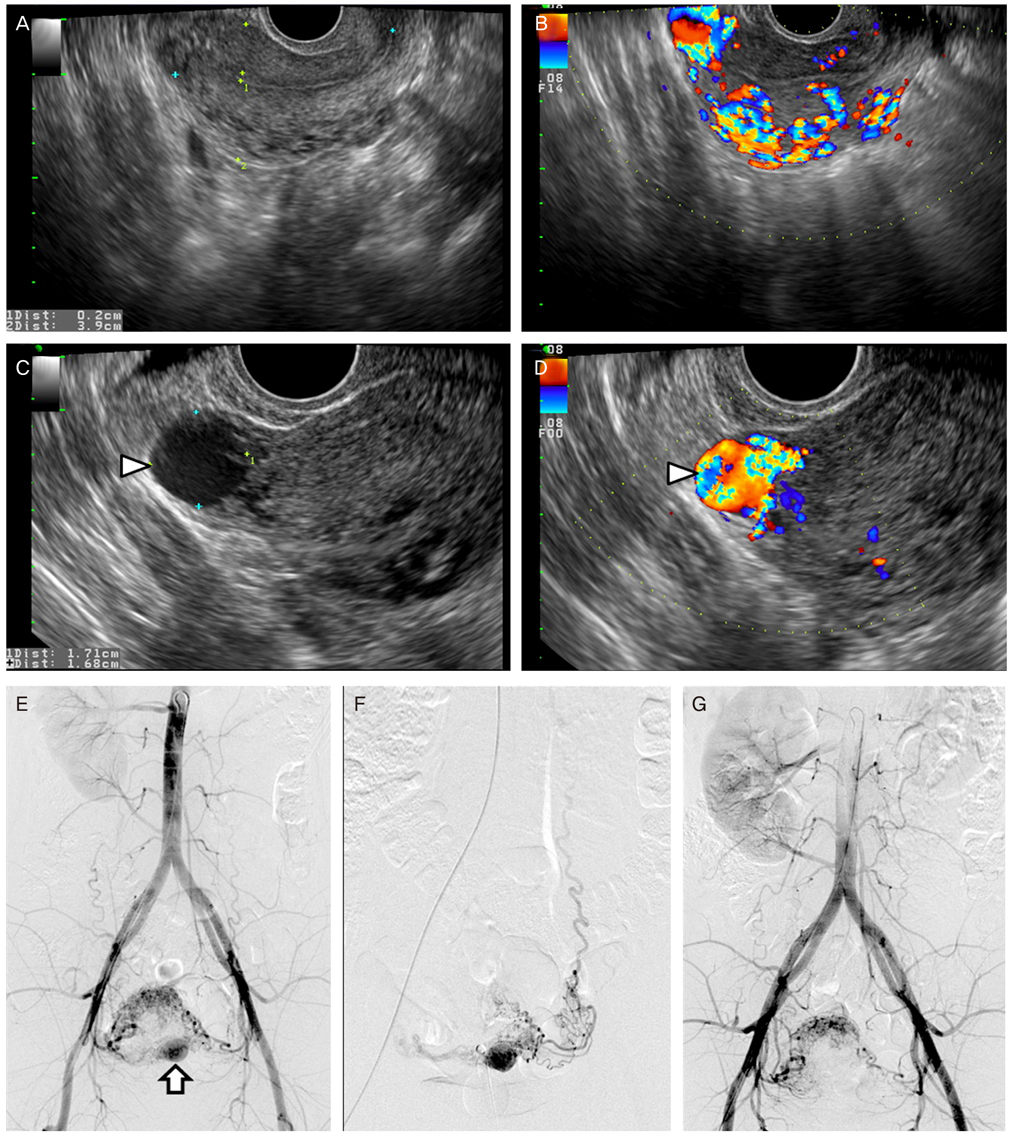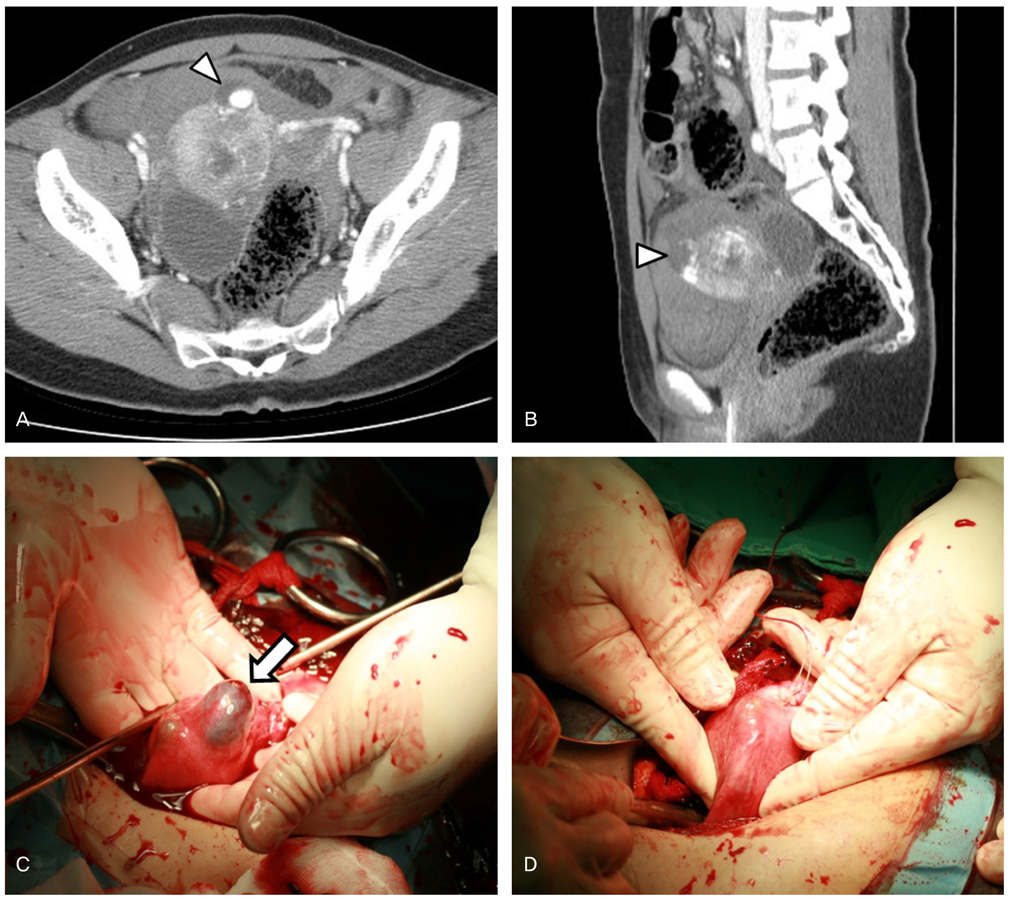Obstet Gynecol Sci.
2013 Sep;56(5):333-337.
Failed transarterial embolization of subserosal uterine arteriovenous malformation
- Affiliations
-
- 1Division of Maternal and Fetal Medicine, Department of Obstetrics and Gynecology, Konkuk University School of Medicine, Seoul, Korea. hwanghs@kuh.ac.kr
- 2Department of Radiology and Research Institute of Medical Science, Konkuk University School of Medicine, Seoul, Korea.
Abstract
- Uterine arteriovenous malformation (AVM) is rare but potentially life-threatening from excessive vaginal bleeding. All uterine AVMs reported to date have been found in the endometrial or myometrial layers. Here we present a patient with a subserosal type AVM on the fundus of uterus, which spontaneously ruptured.
MeSH Terms
Figure
Reference
-
1. Grivell RM, Reid KM, Mellor A. Uterine arteriovenous malformations: a review of the current literature. Obstet Gynecol Surv. 2005; 60:761–767.2. Lin AC, Hung YC, Huang LC, Chiu TH, Ho M. Successful treatment of uterine arteriovenous malformation with percutaneous embolization. Taiwan J Obstet Gynecol. 2007; 46:60–63.3. Brown JV 3rd, Asrat T, Epstein HD, Oglevie S, Goldstein BH. Contemporary diagnosis and management of a uterine arteriovenous malformation. Obstet Gynecol. 2008; 112:467–470.4. Timmerman D, Wauters J, Van Calenbergh S, Van Schoubroeck D, Maleux G, Van Den Bosch T, et al. Color Doppler imaging is a valuable tool for the diagnosis and management of uterine vascular malformations. Ultrasound Obstet Gynecol. 2003; 21:570–577.5. Ginsberg NA, Hammer R, Parihk S, Tamura R, Sabbagha RE. Arteriovenous malformation of the uterus associated with a missed abortion. Ultrasound Obstet Gynecol. 1994; 4:235–237.6. Halperin R, Schneider D, Maymon R, Peer A, Pansky M, Herman A. Arteriovenous malformation after uterine curettage: a report of 3 cases. J Reprod Med. 2007; 52:445–449.7. Nicholson AA, Turnbull LW, Coady AM, Guthrie K. Diagnosis and management of uterine arterio-venous malformations. Clin Radiol. 1999; 54:265–269.8. Molvi SN, Dash K, Rastogi H, Khanna SB. Transcatheter embolization of uterine arteriovenous malformation: report of 2 cases and review of literature. J Minim Invasive Gynecol. 2011; 18:812–819.9. Levy-Zaubermann Y, Capmas P, Legendre G, Fernandez H. Laparoscopic management of uterine arteriovenous malformation via occlusion of internal iliac arteries. J Minim Invasive Gynecol. 2012; 19:785–788.10. Peitsidis P, Manolakos E, Tsekoura V, Kreienberg R, Schwentner L. Uterine arteriovenous malformations induced after diagnostic curettage: a systematic review. Arch Gynecol Obstet. 2011; 284:1137–1151.11. Kobayashi T, Yamazaki T, Takahashi M. Characteristic radiologic findings for cavernous hemangioma of the uterus. AJR Am J Roentgenol. 1999; 172:1147–1148.12. Huang MW, Muradali D, Thurston WA, Burns PN, Wilson SR. Uterine arteriovenous malformations: gray-scale and Doppler US features with MR imaging correlation. Radiology. 1998; 206:115–123.13. Fleming H, Ostor AG, Pickel H, Fortune DW. Arteriovenous malformations of the uterus. Obstet Gynecol. 1989; 73:209–214.
- Full Text Links
- Actions
-
Cited
- CITED
-
- Close
- Share
- Similar articles
-
- A case of angiography and transarterial embolization in arteriovenous malformation of uterus after a cesarean section episode
- A Case of Successful Transarterial Embolization in Arteriovenous Malformation of Uterus
- A Case of Surgical Arterial Ligation in Combination with Transarterial Embolization in the Management of Recurrent Uterine Arteriovenous Malformation
- Cases of Transarterial embolization in Arteriovenous Malformation of Uterus
- Embolization of Uterine Arteriovenous Malformation



